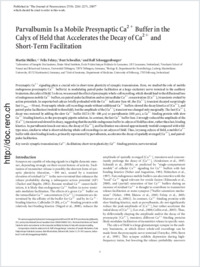Parvalbumin is a mobile presynaptic Ca²⁺ buffer in the calyx of Held that accelerates the decay of Ca²⁺ and short-term facilitation
- Müller, Martin Laboratory of Synaptic Mechanisms, Brain-Mind Institute, École Polytechnique Fédérale de Lausanne, Switzerland - Graduate School of Neural and Behavioral Sciences, Universität Tübingen, Germany
- Felmy, Felix Biology II, Department for Neurobiology, Ludwig-Maximilians-University, Germany
- Schwaller, Beat Unit of Anatomy, Department of Medicine, University of Fribourg Switzerland
- Schneggenburger, Ralf Laboratory of Synaptic Mechanisms, Brain-Mind Institute, École Polytechnique Fédérale de Lausanne, Switzerland
-
2007
Published in:
- The Journal of Neuroscience. - 2007, vol. 27, no. 9, p. 2261-2271
English
Presynaptic Ca²⁺ signaling plays a crucial role in short-term plasticity of synaptic transmission. Here, we studied the role of mobile endogenous presynaptic Ca²⁺ buffer(s) in modulating paired-pulse facilitation at a large excitatory nerve terminal in the auditory brainstem, the calyx of Held. To do so, we assessed the effect of presynaptic whole-cell recording, which should lead to the diffusional loss of endogenous mobile Ca²⁺ buffers, on paired-pulse facilitation and on intracellular Ca²⁺ concentration ([Ca²⁺]i) transients evoked by action potentials. In unperturbed calyces briefly preloaded with the Ca²⁺ indicator fura-6F, the [Ca²⁺]i transient decayed surprisingly fast (θfast, ∼30 ms). Presynaptic whole-cell recordings made without additional Ca²⁺ buffers slowed the decay kinetics of [Ca²⁺]i and paired-pulse facilitation (twofold to threefold), but the amplitude of the [Ca²⁺]i transient was changed only marginally. The fast [Ca²⁺]i decay was restored by adding the slow Ca²⁺ buffer EGTA (50–100 µM) or parvalbumin (100 µM), a Ca²⁺-binding protein with slow Ca²⁺-binding kinetics, to the presynaptic pipette solution. In contrast, the fast Ca²⁺ buffer fura-2 strongly reduced the amplitude of the [Ca²⁺]i transient and slowed its decay, suggesting that the mobile endogenous buffer in calyces of Held has slow, rather than fast, binding kinetics. In parvalbumin knock-out mice, the decay of [Ca²⁺]i and facilitation was slowed approximately twofold compared with wild-type mice, similar to what is observed during whole-cell recordings in rat calyces of Held. Thus, in young calyces of Held, a mobile Ca²⁺ buffer with slow binding kinetics, primarily represented by parvalbumin, accelerates the decay of spatially averaged [Ca²⁺]i and paired-pulse facilitation.
- Faculty
- Faculté des sciences et de médecine
- Department
- Département de Médecine
- Language
-
- English
- Classification
- Biological sciences
- License
-
License undefined
- Identifiers
-
- RERO DOC 7856
- DOI 10.1523/JNEUROSCI.5582-06.2007
- Persistent URL
- https://folia.unifr.ch/unifr/documents/300381
Statistics
Document views: 166
File downloads:
- pdf: 196
